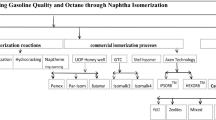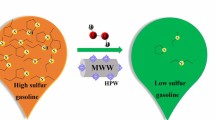Abstract
The experience gained from the industrial use of isomerization catalysts (chlorinated, zeolite, and sulfated oxides) at Russian plants is analyzed. Isomerization has been used in Russia since the late 1990s. Early technologies used zeolite catalysts. The subsequent development of isomerization followed two trends that employed chlorinated and sulfated oxide catalysts. In this work, the advantages and disadvantages of chlorinated catalysts are shown by citing specific examples. The main disadvantages are high sensitivity to water admixtures and sulfur compounds in the raw materials, along with side reactions that yield low octane products in C6 recycling. Sulfated oxide systems are free of such problems, as has been proved in the industrial use of SI-2 sulfated catalyst on different types of plants.
Similar content being viewed by others
References
Bursian, N.P. Tekhnologiya izomerizatsii parafinovykh uglevodorodov (Parffin hydrocarbon isomerization technology), Leningrad: Khimiya, 1985.
Zhorov, Yu.M. Izomerizatsiya uglevodorodov. Khimiya i tekhnologiya (Hydrocarbon isomerization. Chemistry and technology), Moskow: Khimiya, 1983.
Cherner, A.M., Sannikov, A.L., Meling, A.A., Glazov, A.V., Shakun, A.N., Fedorova, M.L., Oil Gas J., 2011, no. 3, pp. 67–72.
Bursian, N.R., Shakun, A.N., Shipikin, V.V., Orlov, D.S., Bosenko, I.I., USSR Inventor’s Certificate no. 810254, Byull. Izobret., 1981, no. 9, p. 45.
Yasakova, E.A., Sitdikova, A.V., Akhmetov, A.F., Oil Gas Bus., 2010, no. 1. www.ogbus.ru.
Kimura, T., Catal. Today, 2003, no. 81, pp. 57–63.
Ezhov, V.V., Melekhin, V.V., Kamalov, K.G., Murashchenko, M.G., Degtyarev, S.G., Borutsky, P.N., Meryshev V.B., Neft. Khoz., 2006, no. 9, pp. 76–79.
Kapustin, V.M., Sosnova, N.A., Smirnov, V.A., Mir Nefteprod., 2014, no. 1, pp. 28–30.
Yadav, G.D., Nair, J.J., Microporous Mesoporous Mater., 1999, vol. 33, no. 1, pp. 1–48.
Author information
Authors and Affiliations
Corresponding author
Additional information
Original Russian Text © A.N. Shakun, M.L. Fedorova, 2014, published in Kataliz v Promyshlennosti
Rights and permissions
About this article
Cite this article
Shakun, A.N., Fedorova, M.L. Isomerization of light gasoline fractions: The efficiency of different catalysts and technologies. Catal. Ind. 6, 298–306 (2014). https://doi.org/10.1134/S2070050414040163
Received:
Published:
Issue Date:
DOI: https://doi.org/10.1134/S2070050414040163




